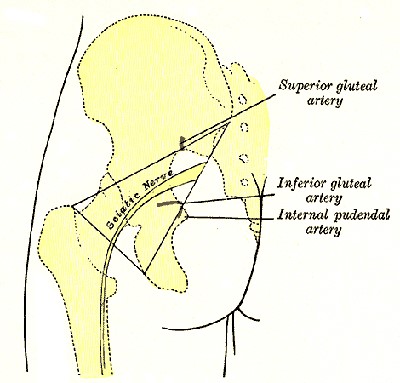Sciatica
Sciatica pain is a pain in the leg. It is caused by compression or irritation of one of five nerve roots that are branches of the sciatic nerve. The pain starts in the lower back. The pain travels to the buttock and sometimes into the leg and foot. In addition to pain, there may be numbness. Muscular weakness is sometimes also present. Therefore difficulty moving or controlling the leg is common. The symptoms are only felt on one side of the body.
Sciatic Pain Nerve Drawing

Sciatica pain is a relatively common form of low back pain and leg pain. But the true meaning of the term often is misunderstood. Sciatica is a set of symptoms. Rather than a diagnosis for what is irritating the root of the nerve, causing the pain. This point is important. Because treatment for sciatica pain or sciatic symptoms often will be different. It will depend upon the underlying cause of the symptoms.
Causes of sciatica pain
Sciatica is generally caused by compression of a lumbar spine nerve root. The L4 or L5 or sacral nerve roots or S1, S2 or S3 nerve roots are the main cause. Or by compression of the sciatic nerve itself. When sciatica is caused by compression of a lumbar nerve root it is considered a lumbar radiculopathy. This is known as radiculitis. It is usually from a spinal disc herniation. That is a herniated intervertebral disc in the spine. Or it could be from roughening, enlarging, and/or misaligning of the vertebrae.
Pregnancy
Sciatica may also be experienced in late pregnancy, primarily resulting from the uterus pressing on the sciatic nerve, and, secondarily, from the muscular tension and / or vertebral compression consequent to carrying the extra weight of the fetus, and the postural changes inherent to pregnancy.
“Pseudo-sciatica”
The compression of peripheral sections of the nerve causes symptoms similar to spinal nerve root compression. This is usually from soft tissue tension in the piriformis. It can also be from related muscles. One possible cause of this is the piriformis syndrome. In this condition, the piriformis muscle, located beneath the gluteal muscles, contracts spasmodically. This is extremely painful. Therefore it strangles the sciatic nerve beneath the muscle. Another cause of sciatic symptoms is sacroiliac joint dysfunction. Unhealthy postural habits, such as excessive time sitting in chairs, and sleeping in the fetal position, along with insufficient stretching and exercise of the relevant myofascial areas, can lead to both the vertebral and soft tissue problems associated with sciatica pain.
Trigger Points
Yet another source of sciatica pain is active trigger points of the lower back and the gluteus muscles. In this case, the referred pain is not, in fact, due to compression of the sciatic nerve. Although the pain distribution down the buttocks and leg is similar. So trigger points occur when muscles become ischemic (low blood flow) due to injury or chronic muscular contraction. The most commonly associated muscles with trigger points triggering sciatic symptoms are: the quadratus lumborum, the gluteus medius, the gluteus minimus, and the deep hip rotators.
Disc Herniation
One cause of sciatica pain is a spinal disc herniation. This is pressing on one of the sciatic nerve roots. Spinal discs are made of cartilage with a liquid center. The discs separate the vertebrae. Thereby allowing room for the nerve roots to properly exit through the spaces between the L4, L5, and sacral vertebrae. The discs cushion the spine from compression forces.
But they are weak to pressure applied during rotational movements. That is why a person who bends to one side, at a bad angle, to pick up a piece of paper may more likely herniate a spinal disc than a person falling from a ladder and landing on his or her back. Herniation of a disc occurs when the liquid center of the disc bulges outwards. This leads to tearing the external ring of fibers. So that compresses a nerve root against the lamina or pedicle of a vertebra, thus causing sciatica.
Stenosis
Other compressive spinal causes include Spinal Canal Stenosis. This is a condition wherein the spinal canal (the spaces through which the spinal cord runs) narrows and compresses the spinal cord. Bone spurs, vertebral dislocation, or herniated discs cause the narrowing. That decreases available space for the spinal cord. Thus pinching nerves in the spinal cord that travel to the sciatic nerve and irritating them with friction.
Piriformis
The sciatic nerve runs through the piriformis muscle in the buttocks region. When the muscle shortens or spasms due to trauma, it can compress the sciatic nerve. This cause of sciatic symptoms is piriformis syndrome, a major cause of sciatica.
Treatment
The approach to treating sciatica pain is to reduce the compression forces that are causing the pressure upon the sciatic nerve. Traction will accomplish this. Adjustments and other realignment therapeutic procedures will also help.
General therapeutic goals include helping the muscles loosen, thereby lessening pain, and to minimize inflammation. Of course we also want to lessen the pain. Restoring normal day to day function is the main goal.
If you have sciatica please call us. Let’s discuss if we can help. 215-343-3223.
